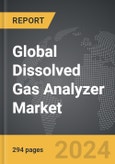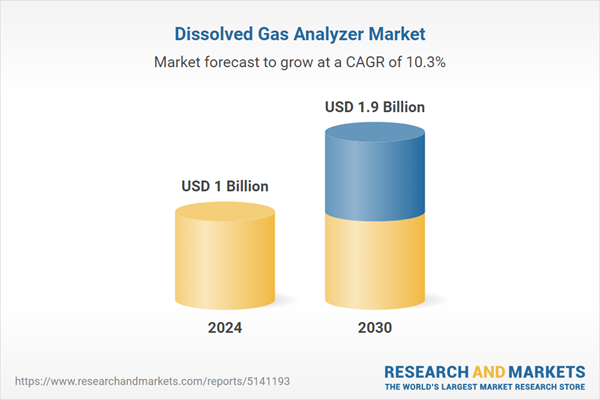The global market for Dissolved Gas Analyzer was valued at US$1.0 Billion in 2024 and is projected to reach US$1.9 Billion by 2030, growing at a CAGR of 10.3% from 2024 to 2030. This comprehensive report provides an in-depth analysis of market trends, drivers, and forecasts, helping you make informed business decisions. The report includes the most recent global tariff developments and how they impact the Dissolved Gas Analyzer market.
Segments: Extraction Type (Vacuum Extraction or Rack Method, Stripper Column Method, Head Space Extraction, Other Extraction Types); Analysis Type (Laboratory Services, Comprehensive DGA Monitoring, Smoke Alarms, Portable DGA Devices, Early Warning DGA Monitoring, Database Software).
Geographic Regions/Countries: World; United States; Canada; Japan; China; Europe (France; Germany; Italy; United Kingdom; Spain; Russia; and Rest of Europe); Asia-Pacific (Australia; India; South Korea; and Rest of Asia-Pacific); Latin America (Argentina; Brazil; Mexico; and Rest of Latin America); Middle East (Iran; Israel; Saudi Arabia; United Arab Emirates; and Rest of Middle East); and Africa.
The analysts continuously track trade developments worldwide, drawing insights from leading global economists and over 200 industry and policy institutions, including think tanks, trade organizations, and national economic advisory bodies. This intelligence is integrated into forecasting models to provide timely, data-driven analysis of emerging risks and opportunities.
Global Dissolved Gas Analyzer Market - Key Trends & Drivers Summarized
What Is Driving the Need for Dissolved Gas Analyzers in Power Utilities?
Dissolved Gas Analyzers (DGAs) play a critical role in monitoring and diagnosing the health of transformers, particularly within power utilities and industries relying on electrical grids. Transformers are essential for energy distribution, and any faults can lead to significant downtime and financial losses. DGAs detect gases like hydrogen, methane, and ethylene dissolved in transformer oil, providing early warnings of internal faults such as overheating or arcing. The ability to monitor these gases in real-time ensures that potential issues can be identified and addressed before they result in transformer failures. The increasing reliance on renewable energy sources like solar and wind, which require efficient energy management systems, has intensified the demand for DGAs. As the energy sector continues to evolve, the emphasis on reliability and efficient maintenance drives the growth of the dissolved gas analyzer market.How Is Technology Impacting the Development of Dissolved Gas Analyzers?
Technological advancements have revolutionized dissolved gas analyzers, making them more accurate, compact, and capable of real-time monitoring. Modern DGAs are equipped with advanced sensors and communication protocols that integrate seamlessly with digital monitoring systems and IoT networks, providing utilities with comprehensive insights into transformer health. Automation and remote monitoring capabilities have become increasingly important, enabling power utilities to manage their equipment efficiently without the need for on-site personnel. Additionally, the use of AI and machine learning algorithms is emerging in the market, allowing for predictive maintenance strategies where systems automatically analyze gas patterns and predict potential faults. These innovations are significantly improving the reliability and lifespan of transformers, reducing maintenance costs and operational risks associated with power outages.What Are the Main Applications of Dissolved Gas Analyzers Across Different Sectors?
While power utilities remain the largest users of dissolved gas analyzers, the applications extend beyond this sector. Industries that rely heavily on uninterrupted power supply, such as data centers, manufacturing plants, and renewable energy facilities, also use DGAs to monitor the health of their transformers. These industries prioritize transformer reliability to avoid downtime and ensure operational efficiency. In addition, government infrastructure projects aimed at modernizing electrical grids are increasingly integrating DGA systems for better monitoring and fault detection capabilities. Transformer manufacturers also deploy these analyzers during testing phases to validate the quality and reliability of their products before installation in critical applications. The versatility of dissolved gas analyzers and their integration into a broad range of sectors demonstrate their indispensable role in modern energy management systems.What Factors Are Driving the Growth of the Dissolved Gas Analyzer Market?
The growth in the dissolved gas analyzer market is driven by several factors, including the modernization of electrical grids, the rising adoption of renewable energy, and technological advancements in predictive maintenance. The shift towards renewable energy systems necessitates the use of DGAs to ensure that the transformers managing variable power loads are operating efficiently. The focus on smart grid development, supported by government investments in infrastructure, is another key driver as utilities integrate DGA technology for improved monitoring and fault detection. Technological innovations such as IoT integration and AI-driven analytics are also propelling market growth by enabling more accurate, automated, and cost-effective maintenance solutions. Additionally, the need for minimizing operational downtime and ensuring the longevity of high-value equipment further encourages the deployment of advanced dissolved gas analyzers in various industrial and commercial applications.Report Scope
The report analyzes the Dissolved Gas Analyzer market, presented in terms of units. The analysis covers the key segments and geographic regions outlined below.Segments: Extraction Type (Vacuum Extraction or Rack Method, Stripper Column Method, Head Space Extraction, Other Extraction Types); Analysis Type (Laboratory Services, Comprehensive DGA Monitoring, Smoke Alarms, Portable DGA Devices, Early Warning DGA Monitoring, Database Software).
Geographic Regions/Countries: World; United States; Canada; Japan; China; Europe (France; Germany; Italy; United Kingdom; Spain; Russia; and Rest of Europe); Asia-Pacific (Australia; India; South Korea; and Rest of Asia-Pacific); Latin America (Argentina; Brazil; Mexico; and Rest of Latin America); Middle East (Iran; Israel; Saudi Arabia; United Arab Emirates; and Rest of Middle East); and Africa.
Key Insights:
- Market Growth: Understand the significant growth trajectory of the Vacuum Extraction or Rack Method segment, which is expected to reach US$1.4 Billion by 2030 with a CAGR of a 10.5%. The Stripper Column Method segment is also set to grow at 8.9% CAGR over the analysis period.
- Regional Analysis: Gain insights into the U.S. market, valued at $272.4 Million in 2024, and China, forecasted to grow at an impressive 14.0% CAGR to reach $418.5 Million by 2030. Discover growth trends in other key regions, including Japan, Canada, Germany, and the Asia-Pacific.
Why You Should Buy This Report:
- Detailed Market Analysis: Access a thorough analysis of the Global Dissolved Gas Analyzer Market, covering all major geographic regions and market segments.
- Competitive Insights: Get an overview of the competitive landscape, including the market presence of major players across different geographies.
- Future Trends and Drivers: Understand the key trends and drivers shaping the future of the Global Dissolved Gas Analyzer Market.
- Actionable Insights: Benefit from actionable insights that can help you identify new revenue opportunities and make strategic business decisions.
Key Questions Answered:
- How is the Global Dissolved Gas Analyzer Market expected to evolve by 2030?
- What are the main drivers and restraints affecting the market?
- Which market segments will grow the most over the forecast period?
- How will market shares for different regions and segments change by 2030?
- Who are the leading players in the market, and what are their prospects?
Report Features:
- Comprehensive Market Data: Independent analysis of annual sales and market forecasts in US$ Million from 2024 to 2030.
- In-Depth Regional Analysis: Detailed insights into key markets, including the U.S., China, Japan, Canada, Europe, Asia-Pacific, Latin America, Middle East, and Africa.
- Company Profiles: Coverage of players such as ABB Group, Doble Engineering Company, GATRON GmbH, General Electric Company, LumaSense Technologies, Inc. and more.
- Complimentary Updates: Receive free report updates for one year to keep you informed of the latest market developments.
Some of the 42 companies featured in this Dissolved Gas Analyzer market report include:
- ABB Group
- Doble Engineering Company
- GATRON GmbH
- General Electric Company
- LumaSense Technologies, Inc.
- Morgan Schaffer
- OELCHECK GmbH
- Qualitrol Company LLC
- SD Myers, LLC.
- Sieyuan Electric Co., Ltd.
- Weidmann Electrical Technology AG
Tariff Impact Analysis: Key Insights for 2025
Global tariff negotiations across 180+ countries are reshaping supply chains, costs, and competitiveness. This report reflects the latest developments as of April 2025 and incorporates forward-looking insights into the market outlook.The analysts continuously track trade developments worldwide, drawing insights from leading global economists and over 200 industry and policy institutions, including think tanks, trade organizations, and national economic advisory bodies. This intelligence is integrated into forecasting models to provide timely, data-driven analysis of emerging risks and opportunities.
What’s Included in This Edition:
- Tariff-adjusted market forecasts by region and segment
- Analysis of cost and supply chain implications by sourcing and trade exposure
- Strategic insights into geographic shifts
Buyers receive a free July 2025 update with:
- Finalized tariff impacts and new trade agreement effects
- Updated projections reflecting global sourcing and cost shifts
- Expanded country-specific coverage across the industry
Table of Contents
I. METHODOLOGYII. EXECUTIVE SUMMARY2. FOCUS ON SELECT PLAYERSIII. MARKET ANALYSISCANADAITALYSPAINRUSSIAREST OF EUROPESOUTH KOREAREST OF ASIA-PACIFICARGENTINABRAZILMEXICOREST OF LATIN AMERICAIRANISRAELSAUDI ARABIAUNITED ARAB EMIRATESREST OF MIDDLE EASTIV. COMPETITION
1. MARKET OVERVIEW
3. MARKET TRENDS & DRIVERS
4. GLOBAL MARKET PERSPECTIVE
UNITED STATES
JAPAN
CHINA
EUROPE
FRANCE
GERMANY
UNITED KINGDOM
ASIA-PACIFIC
AUSTRALIA
INDIA
LATIN AMERICA
MIDDLE EAST
AFRICA
Companies Mentioned (Partial List)
A selection of companies mentioned in this report includes, but is not limited to:
- ABB Group
- Doble Engineering Company
- GATRON GmbH
- General Electric Company
- LumaSense Technologies, Inc.
- Morgan Schaffer
- OELCHECK GmbH
- Qualitrol Company LLC
- SD Myers, LLC.
- Sieyuan Electric Co., Ltd.
- Weidmann Electrical Technology AG
Table Information
| Report Attribute | Details |
|---|---|
| No. of Pages | 294 |
| Published | April 2025 |
| Forecast Period | 2024 - 2030 |
| Estimated Market Value ( USD | $ 1 Billion |
| Forecasted Market Value ( USD | $ 1.9 Billion |
| Compound Annual Growth Rate | 10.3% |
| Regions Covered | Global |









